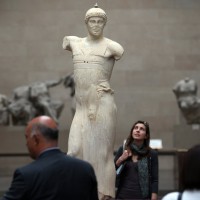-
Major Exhibition of Sicilian Antiquities Highlights Reasons Not To Lend (Or Borrow) Works In The Absence Of A Contract
06/25/2013
 This spring, the Getty Villa in Malibu, California introduced an exhibition of remarkable ancient works from Sicily. The exhibit, titled “Sicily: Art and Invention between Greece and Rome,” features works ranging from rare coins to engraved battle gear; together, the works speak to Sicily’s unique role as a crossroads and center of artistic innovation in the classical world. The Getty exhibition closes in August, after which the works were scheduled to be displayed at the Cleveland Museum of Art this fall. The Getty spent nearly $1 million to mount the show, which the New York Times has called “the first major survey of ancient Sicilian art in the United States.”
This spring, the Getty Villa in Malibu, California introduced an exhibition of remarkable ancient works from Sicily. The exhibit, titled “Sicily: Art and Invention between Greece and Rome,” features works ranging from rare coins to engraved battle gear; together, the works speak to Sicily’s unique role as a crossroads and center of artistic innovation in the classical world. The Getty exhibition closes in August, after which the works were scheduled to be displayed at the Cleveland Museum of Art this fall. The Getty spent nearly $1 million to mount the show, which the New York Times has called “the first major survey of ancient Sicilian art in the United States.”
This week, however, the New York Times reports that Sicilian officials sent a letter to the Getty and the Cleveland Museum of Art, casting a pall over the exhibitions. In particular, the letter highlighted two prominent works—a spectacular gold bowl (called a “phiale”) and a sculpture called “the Mozia Charioteer,” which dates from the fifth century B.C., and, according to the Getty, is “widely considered the finest surviving example of early Greek sculpture in the round.” Sicilian officials argue that these works should not be included in the Cleveland exhibition because their absence is damaging tourism in Sicily. The charioteer sculpture, in particular, has been away from Sicily for over a year (not only for the Getty exhibition, but also for conservation work in the U.S. and a separate loan to the British Museum last year). The letter stops short of actually demanding return of the works, and Getty officials have stated that they are working through diplomatic channels to resolve the issue, but the Cleveland museum may need to decide whether to go forward with its exhibition if it cannot include the sculpture and the phiale.
The tensions come in the context of an evolving and charged relationship between the United States and Italy when it comes to art and antiquities. Indeed, the exhibition was born out of efforts to smooth relations after decades of issues involving allegedly looted Italian artifacts. The exhibition included five pieces of the Morgantina treasure (a collection of metal artifacts returned to Sicily in 2006 by New York’s Metropolitan Museum of Art as part of a resolution of looted antiquities claims), and the phiale itself had been seized as a stolen object by U.S. authorities in 1995 and returned to Sicily. It remains to be seen how this situation will play out, but going forward, Sicilian officials are reportedly considering charging substantial loan fees and restricting travel of masterpieces to foreign museums. On the other hand, exchanges with major American museums can clearly be mutually beneficial, and not just from a publicity standpoint. For example, in connection with the exhibition, the Getty agreed to return to Sicily another disputed work from its collection; paid for conservation work on the charioteer sculpture; and spent $200,000 on a special display stand that would protect the sculpture during an earthquake; when the work returns to its home in Sicily, the stand will accompany it.
Remarkably, despite the high stakes (culturally, financially, and even diplomatically), the debate over the Sicilian exhibition is occurring in a contractual vacuum. According to Sicily’s highest cultural official, Sicily never signed a contract authorizing the exhibition; rather, the works were shipped to the U.S. while negotiations were ongoing. There was a “memorandum of understanding” between the museum and Sicily in 2010, contemplating future collaborations, but that memorandum has since expired. A comprehensive contract governing the Getty exhibition was never signed, and the Sicilian cultural official who spearheaded the negotiations is no longer in office.
Unfortunately, as noted in the New York Times article, it is “not unprecedented” for a museum exhibition to open without a signed contract. The omission here, though, is particularly stark in light of the delicate history behind the collaboration, the political considerations involved in the exchange, the high-profile nature of the exhibition, and the importance of the objects—not to mention the financial resources at stake on all sides (the near-priceless value of the works, the expenses involved in an international undertaking of this scope, the significant investment in restoring and protecting these delicate antiquities, the anticipated revenue to the American museums, and the potential for lost revenue for Sicily while the works are overseas). Indeed, regardless of size or scope, any exhibition or collaboration involving loans of artworks should involve skilled legal counsel and formal agreements to address these types of considerations. With the Getty exhibit, the many complex factors in play should have sparked a sensitive analysis of the costs and benefits to both parties, careful negotiation about who would bear the risks and expenses involved, and a comprehensive binding contract addressing the parties’ rights and obligations. Instead, the parties went forward without those “formalities,” leaving them with little guidance and no clear path, even now that the success of a major exhibition—and an important international effort at cultural cooperation—hangs in the balance.
Art Law Blog
